tunnel
crane wrecker new york central pennsylvania industrial works grand
central terminal penn central conrail metro-north 50021 001 490797
50000 amtrak 16000 X-1 X-45 X-99 cleveland union terminal self
propelled 100 ton 50 ton mncw nyc prr railroad park avenue east river
hudson
DOUBLE
ENDED
WRECKERS OF THE NEW YORK
AREA
and
Cleveland Union Terminal
X-99
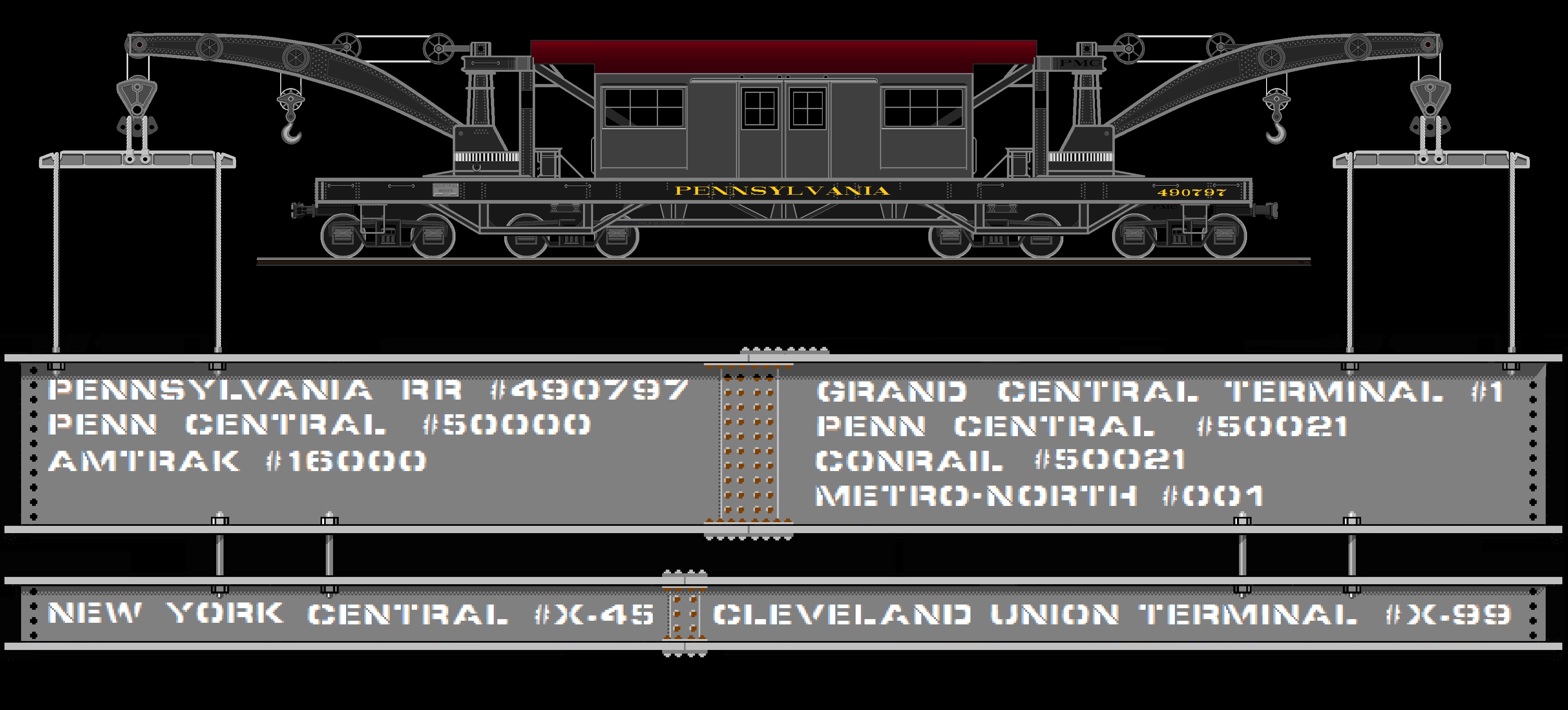
Industrial
Works Brownhoist New
York Penn Central Pennsylvania Cleveland Union Terminal CUT X 99
Maintenance
of Way Connecting X 45 490797 Wellington GCT Conrail 50021 Morris Park
Bronx
Metro North 001 Amtrak 16000 Wreck Derailment Hudson Tubes East River
Tunnel
Station Park Fourth Avenue Rail-crane Derrick Crane Hoist Heavy Duty
Manhattan
Queens City Sunnyside Queens
Electro-Motive Corporation EMC 2280 2281 446 447
www.doubleendedwreckersofnyc.info
|
updated: |
||
| MN 002 ("FDR's" baggage car? NOT!) - Reality: GCT 1 / MN 001 rigging car info added | 11/24/2019 | Grand Central Terminal #1 |

.
.
|
|
|||
|
Pennsylvania RR
#490797 |
Grand Central Terminal #1 |
New York Central X-45 | Cleveland Union Terminal X-99 |
|
|
|||
| Speed & Handling Restrictions | |||
| Double Ended Wrecker Roster | |||
.
.
.
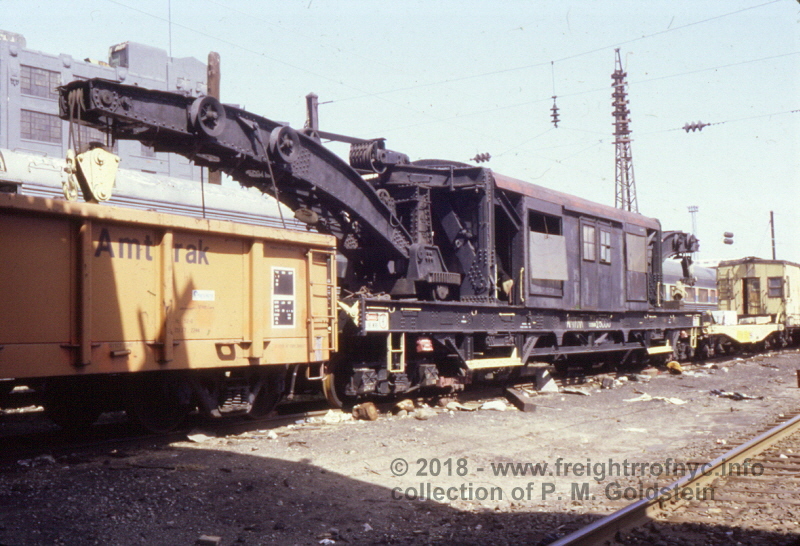
April
1983 - Sunnyside Yard, Queens,
NY
S. Goldstein photo
P. M. Goldstein collection
.
In 1983, my father Stan and I made one of regular "jaunts" to Sunnyside Yards in Queens, NY.
This former Pennsylvania Railroad facility was now the scene for Amtrak, Long Island Railroad and fledgling NJDOT passenger service (pre-New Jersey Transit) action. Don't ask how or why, but we had unparalleled access to the entire yard for many years.
One of my favorite pieces of equipment, was / is a double ended heavy wrecker: Amtrak #16000. Dad photographed this wrecker in April 1983 with Ektachrome, and that was that.
I came across the slides in 2007 while cataloging and reviewing his entire slide archives (on his vintage Honeywell slide projector no less!). So I digitally scanned them and put them on a webpage. But that led me to research it and so, here we are.
.
.
There are two significant reasons why these double enders have been built:
.
.
Why more than one double ended wrecker in New York?
.
The answer to this dates back prior to the 1968 merger of Pennsylvania & New York Central Railroads into Penn Central.
In the beginning, the Pennsylvania Railroad and New York Central Railroad were the two largest Class 1 railroads offering passenger service to New York City.
These two railroads have a long, colorful history of competing with one another for the prestige of passenger service in the Eastern United States. The New York Central, had its New York terminal at Grand Central Terminal, which was accessed via the Park Avenue tunnels, and up through the Bronx. The Pennsylvania Railroad had its Pennsylvania Station, which was accessed from either New Jersey via tunnels under the Hudson River and from Long Island via the East River tunnels.
As we have read so many times in so many books, the Pennsylvania and New York Central Railroads would compete against each other in just about everything: the fastest, ritziest passenger trains to Chicago; the biggest and most modern station; fastest and most powerful locomotives; best appointed and smoothest riding passenger cars; and on and on. It seems petty and wasteful now; but in the glory days of first class railroad passenger travel, there was a lot of money to be made. Air travel was not like it is now. Long distance travel meant going by train. And likewise, if the railroad could show off better than its competition, it could be counted on to do so.
So with that, there was no way pride was going to let one railroad ask it's competitor to borrow a special piece of equipment, like the double ended wreckers. So, it would purchase it own.
Now with pride and competition aside, there was also a practical need for two double ended wreckers in the New York Area. Pennsylvania RR kept their double ended wrecker in Sunnyside Yard, Queens. Sunnyside Yard connects with Penn Station via the East River tunnels and continuing west, then connects to New Jersey via the Hudson or "North" River tunnels. All this is Pennsylvania RR trackage and it should be kept in mind that Penn Station is a "through station", as opposed to an actual end of line terminal, exactly of which Grand Central Terminal was: the New York Central rail line under Park Avenue ended in midtown at Grand Central Terminal. As the old joke goes: A passenger queried; "Say conductor, these here train stop at Grand Central?" and the conductor replied, "Be an awful crash if it didn't!"
So now, lets hypothetically say, a train derails in Park Avenue tunnel, and New York Central Railroad never had their own double ended wrecker. The New York Central Railroad swallows their pride and approaches the Pennsylvania Railroad hat in hand, and asks if can they borrow the double ended wrecker? The Pennsylvania Railroad says sure. But keep in mind: the Pennsylvania Railroad double ended wrecker was pre-positioned in Sunnyside Yard, Queens. There is no direct connection to Grand Central Terminal in Manhattan from Sunnyside Yard!
So, the Pennsylvania Railroad would now have to haul their double ended wrecker from Sunnyside Yard, onto New York Connecting Railroad trackage (a joint operation of the Pennsylvania and New York, New Haven & Hartford Railroads), then over Hell Gate Bridge into the Bronx to the first available junction point with New York Central, which would be at Port Morris.
Here, the double ended wrecker would switch to Port Morris branch of New York Central, and continue northwest to Melrose Junction. Here it would switch to the New York Central Harlem Division trackage and now head south over the Park Avenue lift bridge (over the Harlem River), enter Manhattan and down Park Avenue to the point of derailment.
Quite a journey, isn't it?
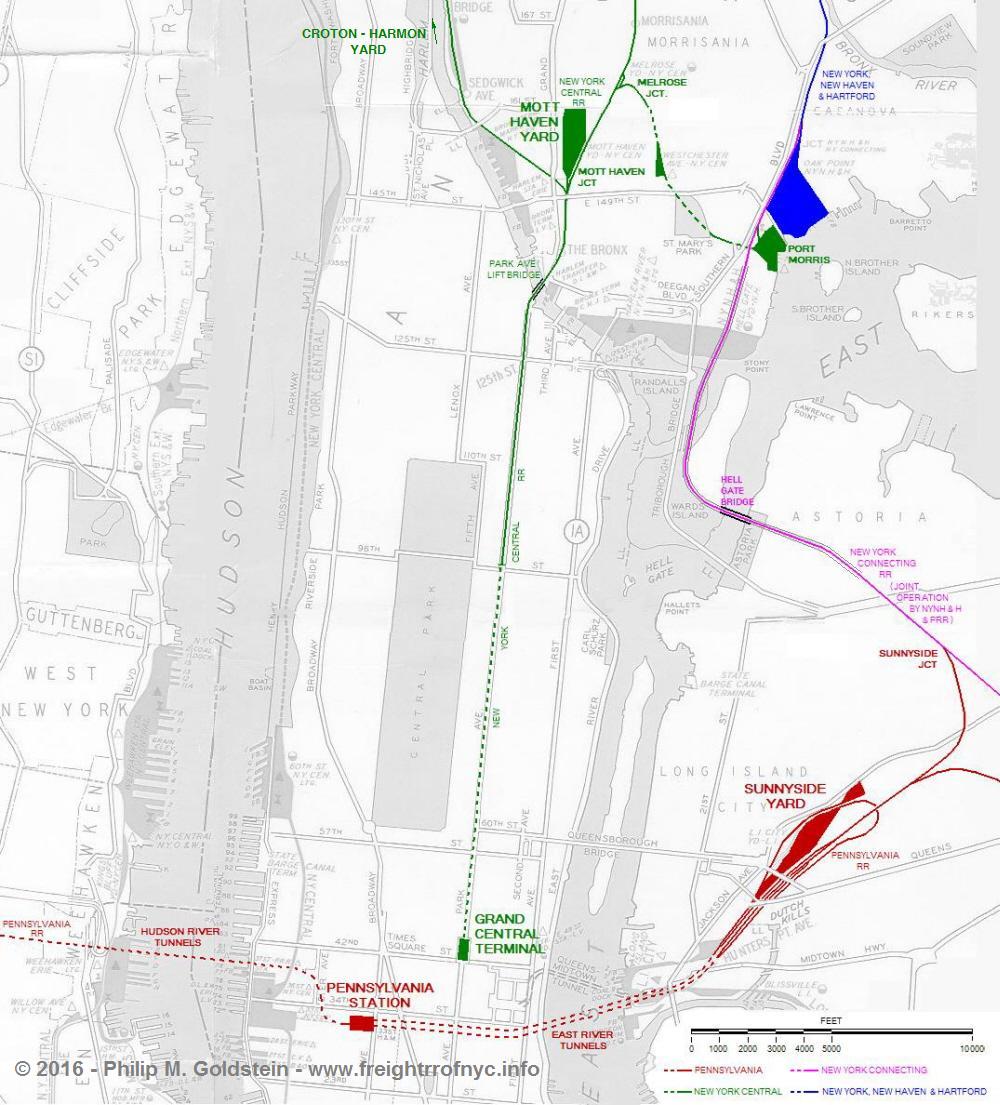
.
So, instead of all this low speed hauling (wreckers of this size had speed restrictions of about 15 to 25 m.p.h.) and switching to and from foreign road trackage (of which these movements have to be shoe-horned into that foreign railroads train schedules); both Pennsylvania Railroad and New York Central would have their own double ended wreckers.
The Pennsylvania Railroad stationed their double ended wrecker at Sunnyside Yard for quick access to the East & Hudson River tunnels.
It is believed but unconfirmed; that New York Central pre-positioned their X-45 double ended wrecker at either Mott Haven Yard in the Bronx (for quick access to the Park Avenue tunnels from the north) or Croton - Harmon Yards in Westchester County, and the northernmost point of trackage electrification for Grand Central Terminal trains. The only image I have located thus far of X-45 in the New York area was taken at Croton - Harmon, so it appears this was the assigned location for X-45 until needed.
Grand Central Terminal #1 appears to have been pre-positioned on one of the storage tracks under Grand Central Terminal to access the fan tracks of Grand Central Terminal, as well as accessing the Park Avenue tunnels from the south.
.
.
Another interesting factoid, is that the New York area double ended wreckers were self powered!
As almost all the passenger trackage in New York area was equipped with either third rail and / or overhead catenary, these wreckers were built with third rail pick up shoes and traction motors on the axles, so they could power themselves.
These wreckers could propel themselves to the scene of a wreck or derailment without the need of a locomotive. This self powered feature saves a great deal of time, as it was not necessary to assign a locomotive, service it, and couple up to the wrecker and take it to the scene of the incident.
Another positive attribute in the design of these wreckers, was their incorporation of a bank of storage batteries, to propel the wrecker even if the electricity was cut off around the scene of a derailment or wreck!
Now it must be kept in mind, most wreckers had a method to move themselves at an extremely minimal speed, but these double ended wreckers could actually propel themselves along trackage at speeds up to 33 miles per hour.
.
.
.
Joseph Roborecky, one of the co-authors on the Industrial & Offline Terminal website (retired Brooklyn Eastern District Terminal locomotive engineer, retired New Jersey Transit assistant engineer); informed me to another bit of important design trivia to consider:
.
Over-riding or Top Contact type "Woods system"
The third rail electrical pick up system used by Pennsylvania Railroad would be of the over-riding type, meaning the third rail shoes (mounted on the trucks of the wrecker) contacted and slid along the top of the third rail.
This system was invented by Granville T. Woods, a prominent African-American inventor, and of whom created a great variety of implements that were directly related to railway operations.
This over-riding or top contact system of third rail is currently in use by Long Island Rail Road (once a subsidiary of the Pennsylvania Railroad from 1900 through 1949) as well as the New York City Transit Authority.
.
Under-riding or Bottom Contact type "Wilgus-Sprague system"
However, the New York Central chose the Wilgus-Sprague system (designed by Frank J. Sprague along with William J. Wilgus). Coincidentally; Wilgus was the chief engineer who designed the dual level terminal arrangement of the current Grand Central Terminal. The Wilgus-Sprague system is better known as the "bottom contact" or "under-riding type" of third rail pick up system.
Obviously, with Wilgus involved, this would be the third rail pick up system that would be selected for use by the railroads leading into Grand Central Terminal; those railroads being the New York Central and the New York, New Haven & Hartford. The Wilgus-Sprague under-riding type system is still in use today by Metro-North Commuter Railroad.
This being the case, wreckers GCT #1 and NYC X-45 would be equipped with the appropriate under-riding type of third rail pick up shoe.
.
Incompatibility
Because of these differences (and without subsequent modifications), the Pennsylvania double ended wrecker #470979 would not be compatible on New York Central trackage and likewise, New York Central double ended wreckers (GCT #1 and NYC X-45) would not be compatible on Pennsylvania Railroad trackage without time consuming modification.
Side note: while unrelated to the double ended wrecker, but worth noting in regards to the two different third rail systems; it would not be until development of the EMD FL9 dual power (diesel-electric / electric) locomotive in 1956, that a mechanism was designed that allowed interchangability between the two different systems of third rail.
.
.
.
In 2009, I came across what I thought was an image on the web of this wrecker in use, while in Penn Central livery. But I noticed significant design differences between the Penn Central double ended wrecker and Amtrak #16000, and I noted them here on the webpage.
Not a few months later, I receive an email from James Thompson (see below) and more information surfaced. This in turn led me on a quest to learn how many double ended wreckers were constructed, who built 'em, when, and if any others survived.
.
15 January 2009
James Thompson sent me the following, on 15 January 2009:
"I have been to the railroad museum in Danbury, CT; and they have a double ended crane there that looks identical to the Amtrak 16000 in the photos on your website.
I am trying to find where the photos I have of that are.
I remember being told by one of the people that work at that museum that the car in question was used extensively in New York City, often times in and around stations to replace / repair track, and sometimes for wrecking purposes, due to the compact nature of the car.
I hope I may have been of some help with this."
.
So, I immediately contacted the Danbury Railroad Museum inquiring about this piece of equipment. Within 15 minutes, I received a reply from Patty Osmer. (Kudos to DRM for a super fast reply!)
Patty sent the following info regarding the wrecker in their collection:
Wrecker/Double-Ended
Crane GCT-1
"Wellington"
.
| ex-Metro-North
001 ex-Penn Central 50021 nee GCT-1 (ownership: 58.057% New York Central / 41.943% NYNH&H) arrived:
Danbury, CT 7/14/98 |
|
"This
unit was built specifically for the tunnels in and around Grand Central
Terminal and has It
is powered electrically from the third rail in the tunnels;
nevertheless, it requires a large number For
a time toward the end of its working days the crane was known as the
"Wellington" in honor Of the three that were built, this is the only one that remains." |
.
So, apparently the Danbury Museum acquired the Penn Central double ended wrecker. But notice it is leased to the Danbury Museum, not sold or donated. I understand there are two reasons for this:
.
Unfortunately, I took note that Amtrak #16000 is not listed as part of the history, so I began to wonder if #16000 was one of the other two cranes built. I believed this because there are significant design differences between Grand Central Terminal #1 and #16000 (sheave orientation, boom swivel supports, curvature of the boom, window and door size & placement, etc), so I didn't think GCT #1 was #16000.
But, I also took note of the statement: "Of the three that were built, this is the only one that remains." Three?
.
17 November 2010
While perusing the NE Rails page http://www.northeast.railfan.net/mow6.html , I began looking through the crane images and I happened across an image of Pennsylvania Railroad double ended wrecker #490797. Lo & behold, she is identical to Amtrak #16000. Sheave orientation is correct as is window style and door placement.
I also looked through my archives and did a little further comparison between Grand Central Terminal #1 / Metro-North #001 double ended wrecker and the image of Penn Central's double ended wrecker. These two cranes appear to be identical as well, but slightly different from PRR 490797 / Amtrak 16000.
Therefore it became my contention (by examining the photos I had at my disposal), that Pennsylvania #490797 became Amtrak #16000; and Grand Central Terminal #1 became Penn Central #50021, which in turn became Metro-North #001.
.
27 January 2012
So, a few years goes by and my research on this subject has reached an idle point. Then I receive an email from John Taubeneck, and he was able to provide builders information on both wreckers. This information bore out my hypothesis on PRR #490797 / GCT #1 being separate units.
.
02 February 2012
At the suggestion of John Taubeneck, I contacted John LaRue (who also has an extensive library of materials and images) for his input.
John LaRue concurs with almost all of my hypothesis and conclusions, and had the following to add to the webpage: Industrial Works / Industrial Brownhoist Catalogs! So, he generously scanned the appropriate pages and I include them here:
And this breaks loose a flurry of correspondence between John Taubeneck, John LaRue, myself with Paul Strubeck searching the web for documents. I am indebted to all these gentlemen for there assistance and contributions, despite their apologetic attitude for creating more questions than we are answering!
.
04 February 2012
And the purpose of this webpage, is to get the Double Ended Cranes noticed and history sorted out. It appears that this is working!
On this date I received an email from Lon Godshall, who is compiling a roster of Amtrak Maintenance Of Way equipment:
"I enjoyed your website and the subject of the double ended cranes. I am putting together an Amtrak MW roster and stumbled upon it and can add some Amtrak info.
I have two separate documents that declare assets given to Amtrak from Conrail/PC and one says the Sunnyside wreck train is an electric crane w/ 50 ton rating, boom on both sides and is PC 50000. It also lists the entire wreck train by each car number. The other document says it is a double boomed crane w/50 ton rating and gives the number as 50000 as well.
Wayner's 1980 Amtrak car spotter guide (1980) lists the crane as 50 ton as well.
Although it is theorized the crane was upgraded to a 100 ton crane, it appears the railroad either downgraded it, or it never was upgraded.
I have a 9/1983 Amtrak MW roster and the 16000 was just removed as the listing has obviously been whited-out. If you like copies of any documents, just yell."
We're yellin;' we're yellin'!
So, with this latest contribution from Lon, we now know that PRR 490797 became Penn Central #50000 before it became Amtrak #16000. However, this wrecker was transferred directly to Amtrak from Penn Central and did not become part of Conrail's roster.
These documents can be viewed in the PRR #490797 chapter below.
.
Industrial Works: c/n 2280 - built 1911
Pennsylvania
RR
#490797
Penn Central #50000
Amtrak #16000
.
Referencing the following image, relates that #490797 had 50 ton capacity (each boom).
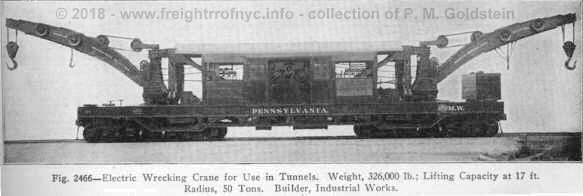
via
Sam
Berliner
added 31 January 2012
.
But, the unit in the image looks identical to Amtrak #16000, (of which we know was a descendant of 490797), and looks remarkable similar to GCT #1, but which had 100 ton lifting capacity (each boom).
John Taubeneck's list as he furnishes relates the entry as c/n 2280 Pennsylvania RR #490797 (1st). There is no reference or listing for a 2nd PRR #490797. Since original Industrial Works / Industrial Brownhoist builders records have not been released to the public, the list has been compiled utilizing railroad records, historian & railfan accounts. There are numerous gaps in the numbering sequence.
It is undocumented if the first 490797 (built as 50 ton capacity in the image above) was subsequently upgraded to 100 ton capacity, or whether 490797 (second) was a completely different unit, or a second 490797 was ever constructed.
It was my hypothesis that PRR 490797 (1st) was originally built as a 50 ton in 1911, and returned to Industrial Works to be upgraded to a 100 ton circa 1915, but retained her original PRR road number of 490797, but referred to as the 2nd.
After discussing this at length with Paul Strubeck, the following was agreed upon: as only the booms swivel and not the cab (as conventional wreckers do), additional counterweighting to increase lifting capacity was not needed. As far as it is known by us, increasing the lifting capacity would be accomplished by adding additional sheaves to the cable system and perhaps increase the horsepower of the electric motors winding the sheave cable. But the outward appearance of the chassis and body would remain unchanged.
Therefore, this hypothesis would also
conceivably explain:
.
.
Perhaps the most foretelling fact that supported my hypothesis, are the many entries in John Taubeneck's' list which show many 50, 60 and 70 ton wreckers being returned to Industrial Hoist for upgrading to heavier lifting capacity, and every one of those appears to have been upgraded to 100 tons; never more and never less.
The only issue at this point is why PRR #490797 (c/n 2280) shares a consecutive construction number with GCT #1 (c/n 2281), despite being built three years earlier? (Are you trying to tell me Industrial Hoist built not a single crane or wrecker between 1911 (PRR 490797) and 1914 (GCT #1) ? Well, I don't believe it.
A possible answer is that 490797 was built in 1911 under a earlier construction number (there are gaps in the numbering at earlier dates on John Taubeneck's list). Upon upgrading to 100 ton in 1914, 490797 was issued a new construction number; but either due to oversight or policy, the original build date remained as 1911 on the list. This is very probable, as if our "rebuild hypothesis" is correct and in fact 490797 only needed additional sheaves and maybe higher capacity motors to increase lifting capacity; the chassis and body remained as before, and having still been built in 1911.
Here is an apt analogy: you purchase a 1971 car with the original 350 cubic inch small block engine rated at 245 horsepower. But in 2001 you decide to replace the original engine with a modified 350 cubic inch small block engine into the car, rated at 390 horsepower. The chassis and body remains the same, as does the vehicle identification number (vin), it is just the guts that were upgraded and capacity increased by 145 horsepower!
Now the following is from John LaRue and is a scan of the Industrial Works General Catalog from 1923 - Pages 118 and 119. Note the capacity given for #490797 is 65 tons! This is the only published reference to this wrecker having a capacity greater than 50 tons. Also take note that only PRR #490797 is the only double ended wrecker with a mid-boom auxiliary winch.
It is believed that the catalog takes into the combined capacity of the main winch (at the tip of the boom) AND the auxiliary winch "whip line" (located at mid boom). If this is correct, this would give the auxiliary winch a capacity of 15 tons using simple mathematics: 65 ton total lifting capacity - 50 ton capacity main boom winch = 15 tons remaining for the mid boom winch.
However, both PRR #490797 and GCT #1 are equipped with two sheave wheels on the outsides of boom. This is for a whip line for auxiliary winching use; i.e.: Once the main boom has lifted the load e.g. a derailed passenger car; the auxiliary winch and line would be fastened to the passenger cars truck. Now with the passenger car lifted free, the truck is free to move as well, and auxiliary winch will drag the truck free out from under the passenger car body. It is sort of like an extra pair of hands.
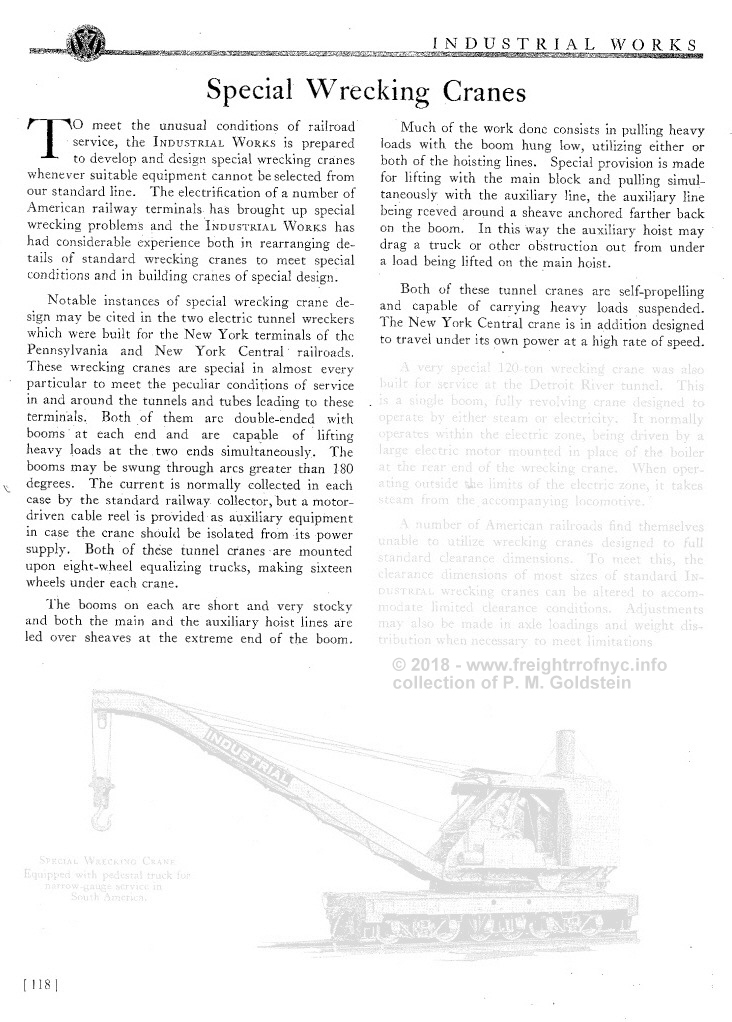 |
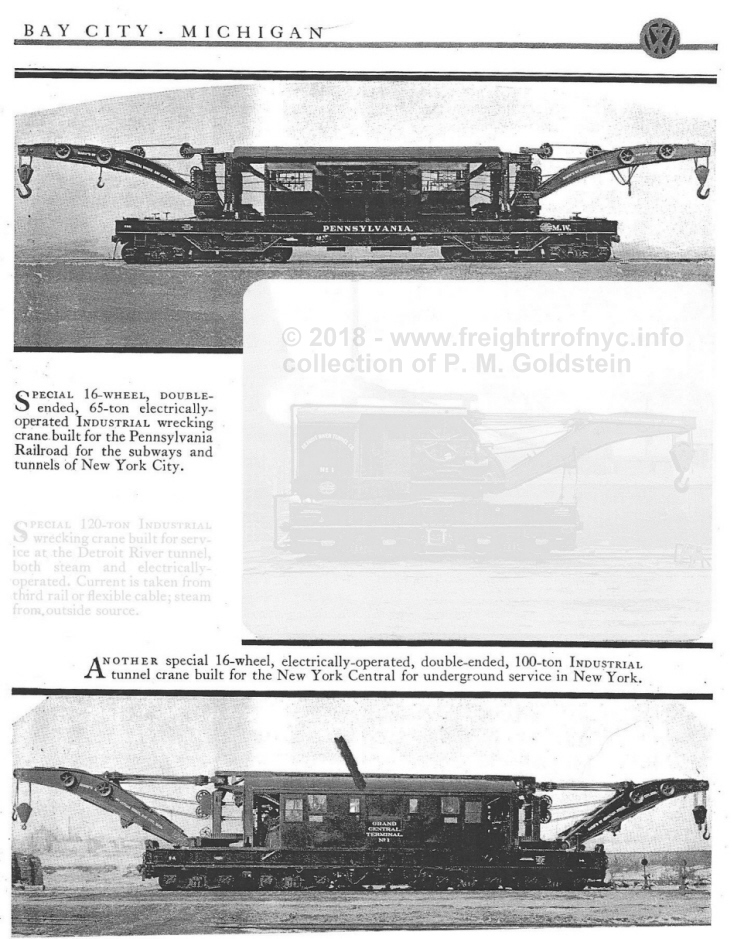 |
| Industrial Works General
Catalog
1923 - Page 118 & 119 collection of John C. La Rue, Jr. added 05 February 2012 |
|
.
As John LaRue's delves into his archives further, he discovers a trend that is most contradictory to my hypothesis: throughout the years, all references to #490797 refer to it as 50 ton capacity, even as late as the 1940's. And nowhere in official Pennsylvania RR documents (profile drawings, etc) does it state it was upgraded to 100 ton capacity.
Here are his points:
"First up is PRR 490797. Several sources all say the same thing: it is a class W-50A, 50-tonner. The first is the ICC valuation report. This has no date but is probably from 1918. It describes 490797 as: "Electric Wrecking Derrick - Double End: No. 490797; all steel; length 61'; 2-50 ton capacity; Industrial Works, 1911."
[The following] is undated PRR tracing E-67363, reproduced in Bob Johnson's collection of PRR profile drawings.

Click on above illustration for enlargement.
(Use back arrow on browser to return you here.)
B. Johnson collection
digitally cleaned by
author
added 03 February 2012
.
Unfortunately it gives no builder, date, or serial number, but it is headed: "16 wheel tunnel crane, class W-50A". PRR wrecker classes were based on the maximum tonnage rating. W-50A appears to be the only one in its class, as rosters all show it separate from all the other class W-50 wreckers. More telling is the notation on the right end of the tracing:"Capacity at 22'0" radius - 100,000 pounds" In any man's book, that is 50 (short) tons.
The drawing is unfortunately not dated, so there is no telling if it was made before the crane was upgraded. But rosters as late as 1949 all show it in class W-50A. Theoretically, if it had been upgraded, a new class number should have been assigned. There were regular W-100 wreckers, plus W-100A and W-100B.
Somewhere on that wrecker there should have been a cast plate giving data such as serial number, date, and most importantly, the lifting capacity at various radii. Pity you did not find it and take a sharp picture of it.
Other rosters contain somewhat similar data. One from 12-31-41 confirms a 1911 date. Another, from a copy of a 1949 PRR drawing listing class numbers for all wreckers, confirms the 2280 serial number.
I cannot account for this persistent tendency to give the capacity of 490797 as 50 tons. Could be there was a financial reason.
The PRR kept historical records of its work equipment on large file cards. Someone once sent me xeroxes of three of them. I have no idea where those files are, but the one for 490797 might provide an answer."
...
The following scans are furnished by John LaRue as well:
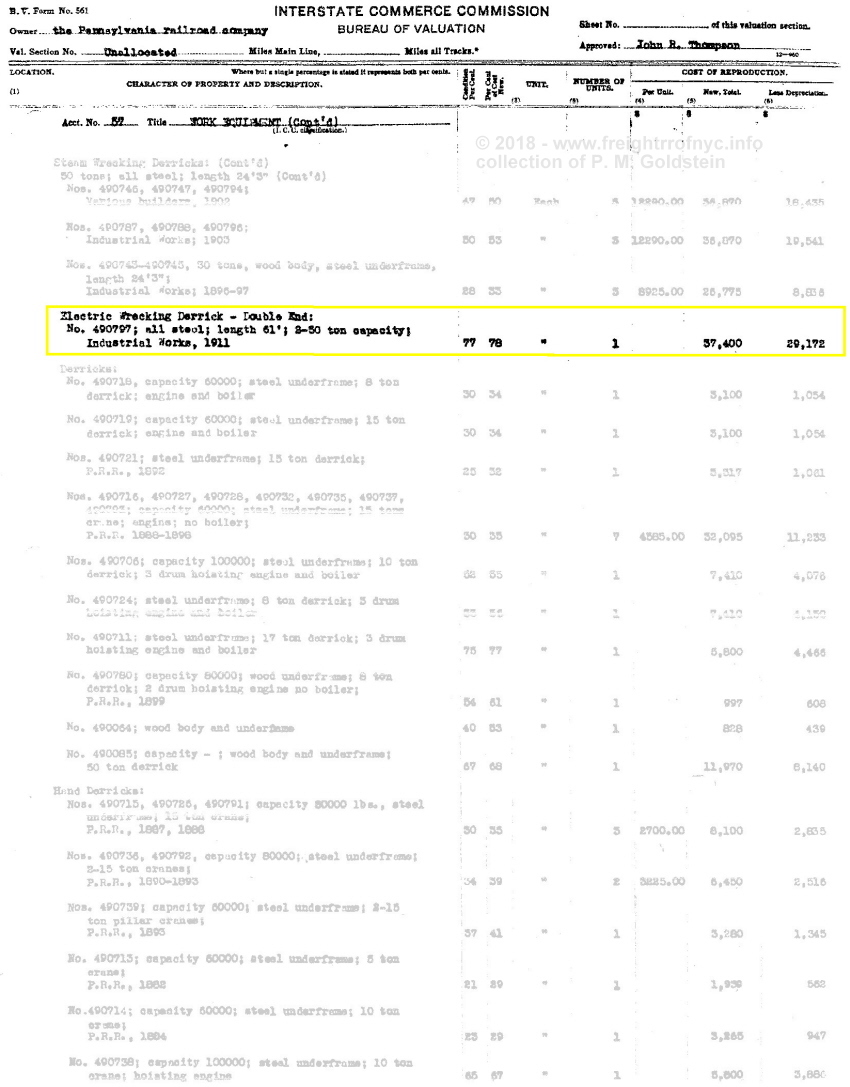
Interstate
Commerce Commission
Valuation Report - unknown
date (ca. 1918?)
J. LaRue
archives
added 04 February 2012
.

PRR
Wrecking Cranes Class Badge
Plate Sheet - 1951
Note that #490797 is still listed as Class W50A
J. LaRue
archives
added 04 February 2012
.
.
So with this latest round of correspondence with John LaRue, that I (PMG) am now leaning towards the very real possibility, that PRR #490797 WAS NOT upgraded to 100 tons, and all entries on this page have been amended to reflect such, until data arrives confirming said upgrade actually took place.
As previously stated in the previous chapter, Lon Godshall furnished several documents regarding the transfer of Penn Central #50000 to Amtrak. Thanks to these documents, we able to ascertain Penn Central's road number for this wrecker.
The first document is an "internal memo" by National Railroad Passenger Corporation (better known as Amtrak), dated December 23, 1975 and reflects the Amtrak designations for equipment being acquired from Penn Central:
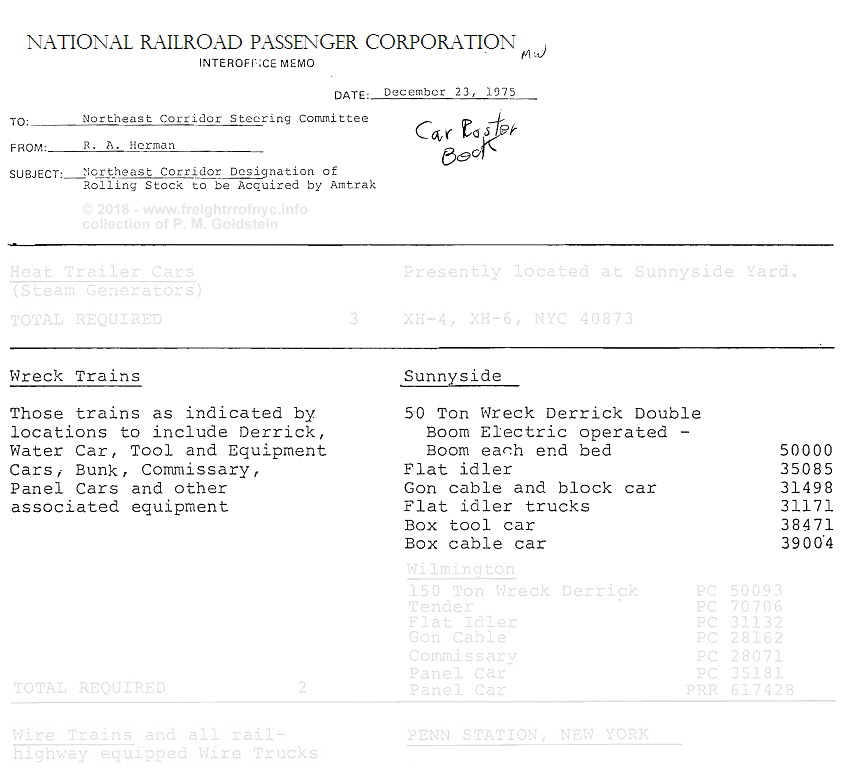
National
Passenger Railroad
Corporation (Amtrak)
Interoffice Memo on Designation of Rolling Stock acquired from Penn
Central
- December 23, 1975
Lon Godshall
collection
added 05 February 2012
.
.
This next document, is a "Security Agreement" filed with the Interstate Commerce Commission (now the Surface Transportation Board) Rail Recordation, Recordation Number 8271, dated 3/31/1976 and officially filed on 4/1/1976. It shows most if not all equipment to be transferred to Amtrak from Penn Central and Conrail:
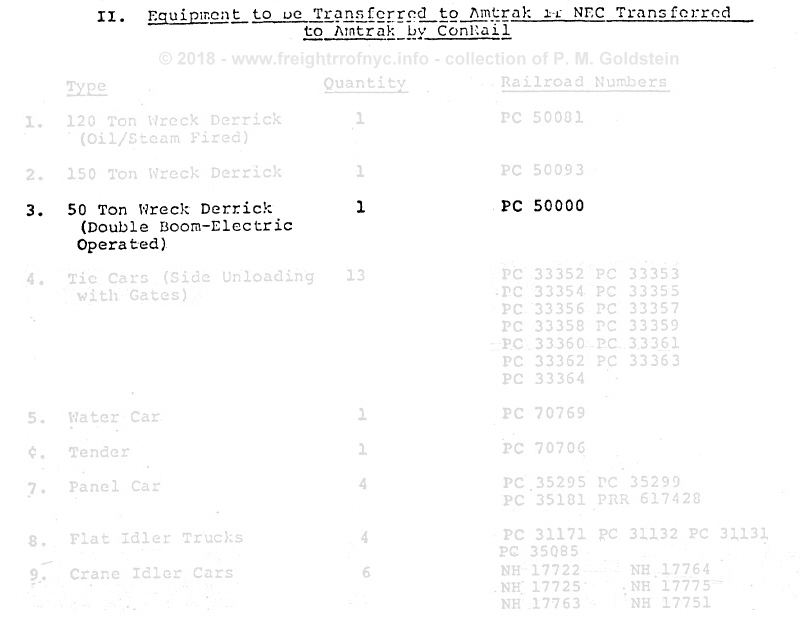
Surface
Transportation Board Rail
Recordation, Recordation
Number 8271,
date: 03/31/1976 - filing date: 04/01/1976 - time: 05:25:00 PM
- type:
Security Agreement
Surface Transportation Board archives
Lon Godshall
collection
added 05 February 2012
The unabridged and complete filing of this document may be viewed here:
Interstate Commerce Commission ‘Amtrak Equipment Roster - Recordation Number 8271
.
The third and final document sent by Lon, is a Security Agreement filing containing most, if not all; of Amtrak's Roster of Equipment. The .pdf document on file with the Surface Transportation Board (the successor agency to the Interstate Commerce Commission) is huge (93 pages), and only the redacted entry of 16000 and those immediate pieces of equipment before and after the redacted entry are excerpted here:
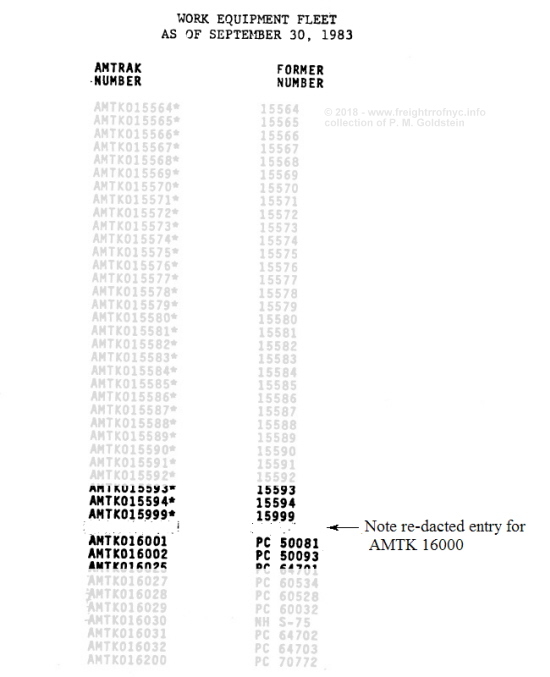
Interstate
Commerce Commission "Amtrak Equipment Roster
- Security Agreement 6690-MMMM" p. 89 - September 30, 1983
Showing redacted AMTK 16000.
Lon Godshall
collection
added 05 February 2012
.
.
The unabridged and complete filing of this document may be viewed here:
Interstate Commerce Commission ‘Amtrak Equipment Roster - Security Agreement 6690-MMMM"
Naturally, anyone with information or dated photos proving or disproving this hypothesis, is more than welcome to contact me at bedt14@aol.com .
.
.
.
Industrial Works c/n 2281: - built 2/1914
Grand
Central Terminal
"GCT" #1
Penn Central #50021
Conrail #50021
Metro North #001
.
There is no doubt or questions regarding the pedigree of Grand Central Terminal #1, as it is well documented upon construction. Several journals of the time: "Electric Railway Journal", "Railway Age Gazette" and "Engineering Record" to name a few, published feature length articles on expounding the design and construction of Grand Central Terminal #1.
Paul Strubeck, always having been especially good at internet research; located the following digitized magazine articles (all dated 1914), on the building of Grand Central Terminal #1 and I have been adding others to my collection as I locate them for purchase.
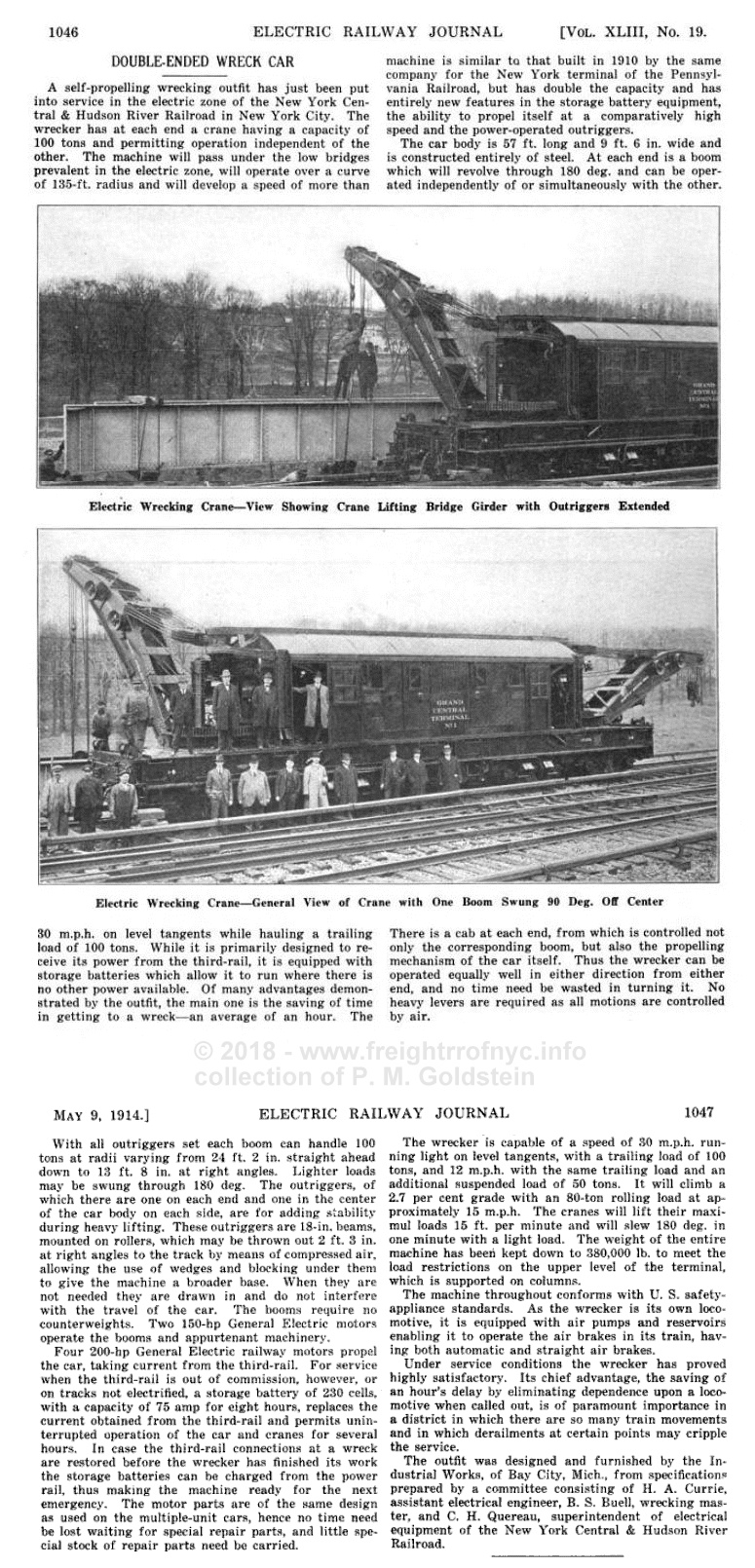
May 9, 1914 - Electric Railway Journal
Google
Books
added 29 January 2012
.
.
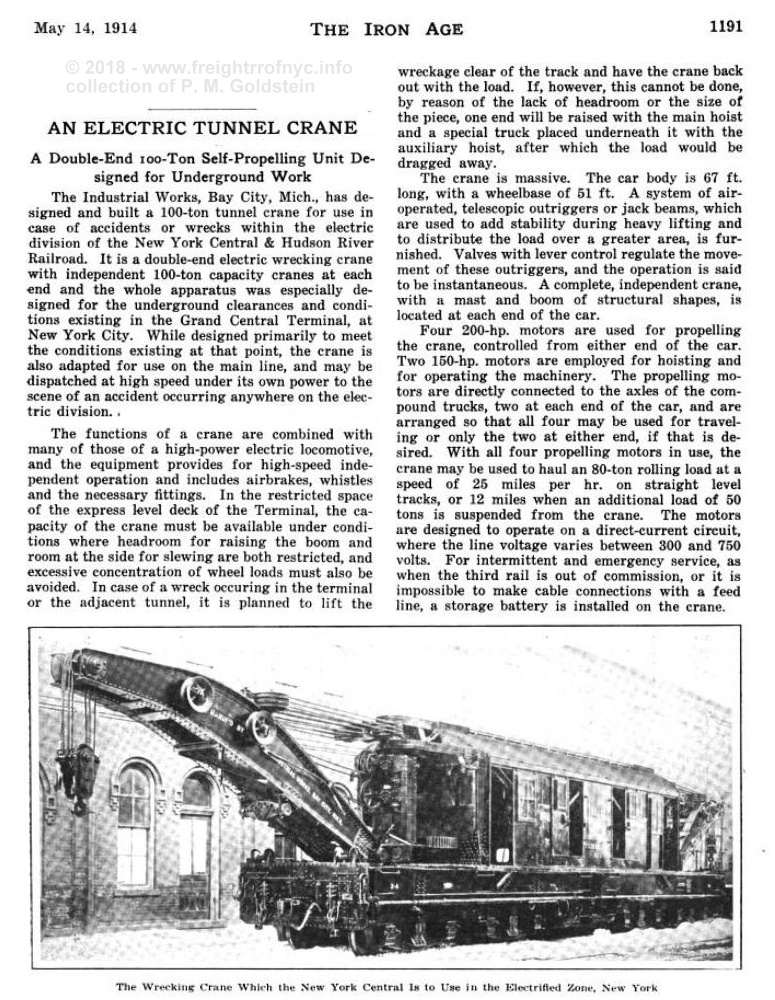
Iron
Age - May 14, 1914
Google Books
added 29 January 2012
.
.

Engineering
Magazine - August 1914
Google Books
added 29 January 2012
.
.
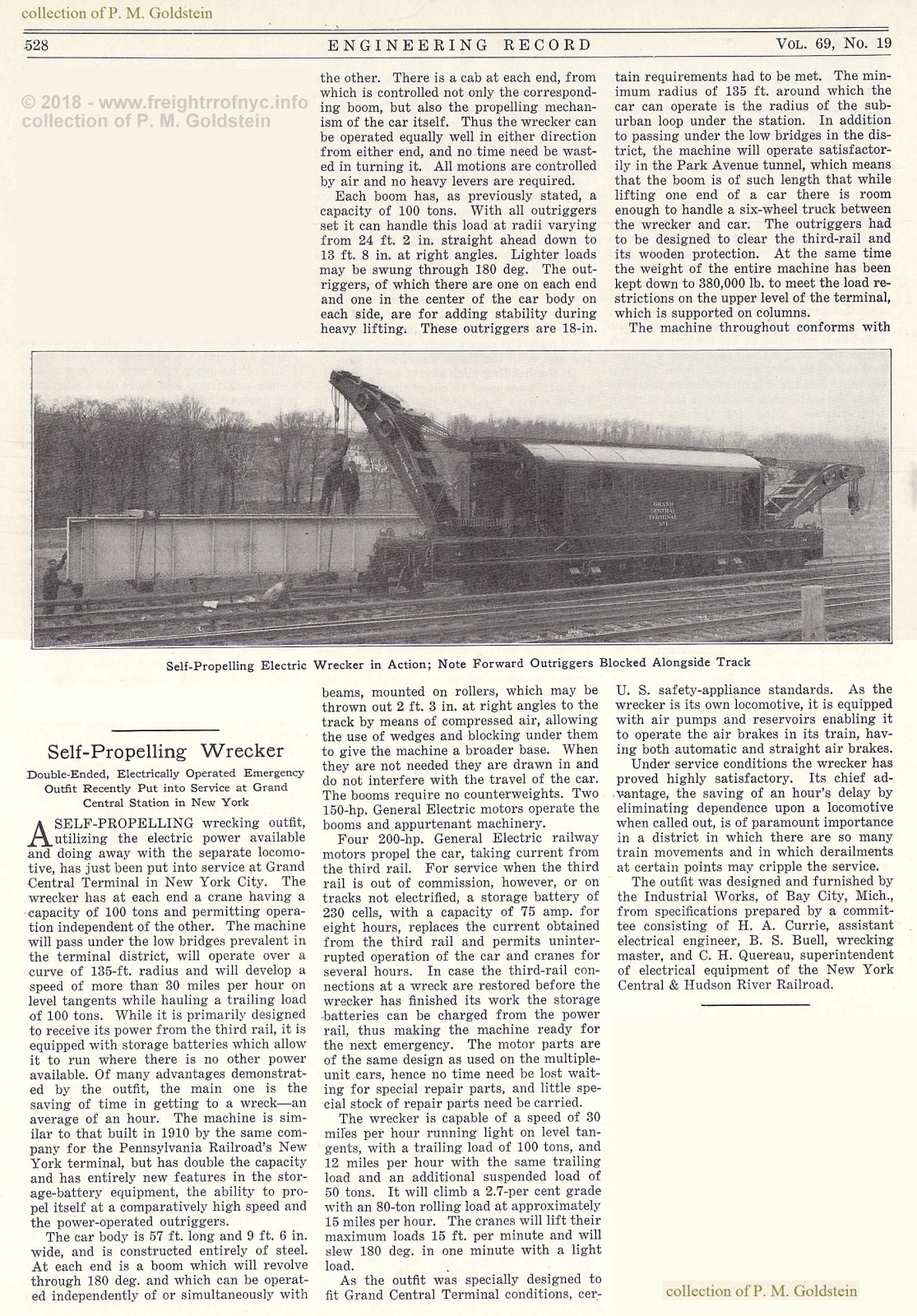
Engineering
Record - Volume 69, No.
19 - May 9, 1914
authors collection
added
06 November
2016
.
.
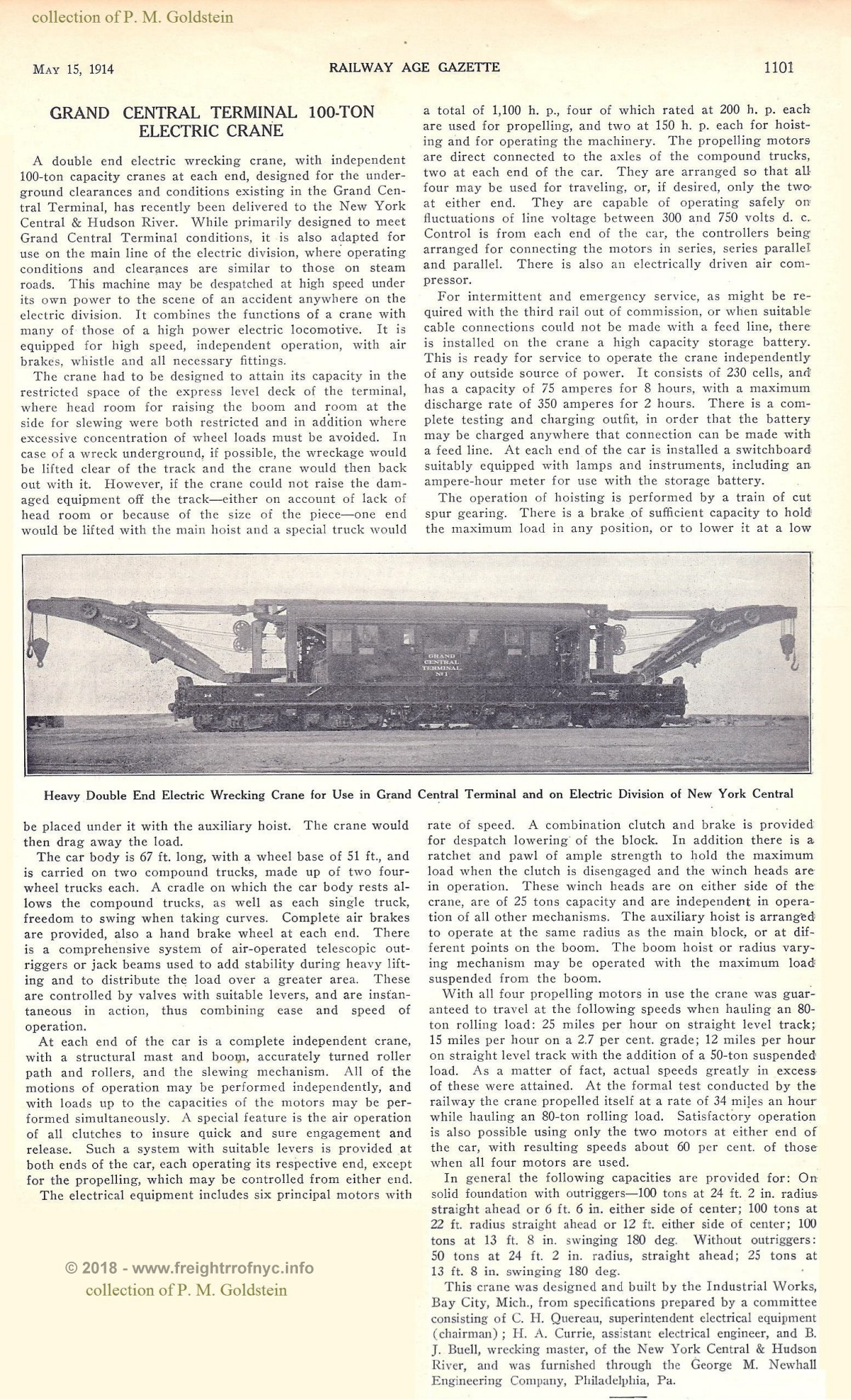
Railway
Age Gazette - Volume 56, No.
20 - May 15,
1914
authors collection
added
06 November
2016
.
.
Despite all this early publicity, this not to say GCT #1's history gets somewhat muddled in later years. John Taubeneck's list shows that GCT #1 was renumbered New York Central #X-1 and then New York Central #X-45 in later years, before becoming Penn Central #50021. As it turns out, this is incorrect and we will see why shortly.
Also, on 03 February 2012, I also received a reply to my inquiry regarding available information on Metro-North #001 (ex-GCT #1) from Ted Bowen, Manager; Metro-North Customer Service Center:
"Metro-North inherited the double ended wrecker "MN #001" from Conrail in 1983. (Penn Central transferred their rail assets to Conrail in 1976.) Unfortunately, I do not know that piece of equipment's pre-MNR history. You may want to check with Conrail's offices in Philadelphia."
So at the very least, we now have a date of when Metro-North acquired GCT#1 and from whom (Conrail).
On 04 May 2012, John Taubeneck sent the following additional info in an email:
I recently got a stack of New York Central, Penn Central and Conrail wrecker papers. There was a little on your double enders so I am passing it along. A New York Central report from May 15, 1963 lists the Grand Central Terminal #1 as in service based at Grand Central Station and last shopped in 1936.
MN 002 - the "FDR" Baggage Car (not!) - GCT 1 / MN 001 rigging car (yes!)
Circulating for years had been a rumor that a baggage car located on Track 61 of the Grand Central Terminal and under the Waldorf Astoria Hotel, had been used in President Franklin D. Roosevelt's train for transportation of his automobile, etc..
While this urban rumor has now been proven to be incorrect,
it
still remains
frustratingly hard to "kill" the rumor. Time and time again, in
both railfan
and
historical New York groups and forums; I see reference to it as "FDR's
baggage car". The more knowledgeable historians try to post the
correct info, but that post usually gets lost amongst all the "oohs"
and "ahhs".
From what I (and others) have been able to discern, the
rumors
originated from a now disgraced docent who provided
tours of
Grand Central Terminal (with some of these tours not being
officially sanctioned by MetroNorth and of which led to his
being
released). It also appears this docent also played fast and
loose
with the facts, and not just in regards to this baggage car.
Most naturally, "FDR's secret car" made for good copy and memories for and of the casual tourgoers as well as the press, it is however sadly not rooted in any fact. The car has been and remains nothing more than a mundane run of the mill baggage car converted to a maintenance of way car. Its claim to fame however is that it survived; and for me and this website, is part of the wrecking train that was headed up by MN 001!
Now, in a recently published (9/27/2019) article in NYC Urbanism, an online blog; it has been written:
"So what was the car used for? Grand Central used the Baggage Car 002 to transport the rigging for a hundred-ton capacity electric double-ended crane in Grand Central’s tunnels before being left on Track 61. The Danbury Railway Museum estimates the car was under Grand Central for 20 - 30 years."
This would make sense as GCT #1 was renumbered MN 001 later in its career and is known to have prepositioned at Grand Central Terminal. And as the baggage car is consecutively numbered MN 002, well; it seems much more plausible as a support car to the double ended wrecker than being "FDR's baggage car".
While GCT 1 / MN 001 was removed and subsequently wound up at the Danbury Railway Museum a few decades back, MN 002 remained stored on Track 61 to be used for (what else?) storage. The wrecker was no longer needed; but with any and all storage being useful, the baggage car remained. Time passed, rumors got started and its true history lost in the shuffle. Until now.
Furthermore, I am not the only one to have covered this overzealous historical fabrication: the following is link to very well composed article about of MNCR #002 dated 12/1/2019:
On May 31st, 2019; MN 002 was transported by MNCW #108 [GP35R] (ex-CNW 831 - c/n 28966, and rebuilt by Brookville Locomotive in December 2018) along with an EMD FP10 (EMD F10) #413 (ex-GM&O 880A - c/n 3600) to the MetroNorth Highbridge Shop for inspection and restoration.
For the sake of thoroughness, the history of Baggage Car MN 002 is as follows:
built by Standard Steel Car Company (SSC) in 1911 as New York Central #3177, Heavyweight Baggage Car.
Renumbered NYC 7847 (unknown date),
transferred to Penn Central roster in 1969,
transferred to Conrail roster in 1976
transferred to MetroNorth roster in 1983.
Donated to Danbury Railway Museum, Danbury, CT 12/2019.
I really hope between all this new publicity and research by myself and other accredited historians (if you were not to consider myself one) - this urban rumor can finally be put to bed, kissed goodnight and the light turned off.
.
.
Industrial
Brownhoist: c/n unknown
Electro Motive Corporation: c/n 446 - built 8/1930
Continuing with John LaRue's research,
"Moving on to the New York Central, the Interstate Commerce Commission (ICC) valuation report shows where the X-1 for their double-ender came from; that is what they call it. The entry is not too legible; my copy came from the Edson collection, which was second generation to start with, and the sheet is fourth generation at the very least.
The ICC valuation reports, I find, are not always trustworthy. Much depended on the care of the field team gathering the raw data, but for something like a car number, I would expect it to be accurate.
There is a roster of New York Central work equipment on the Canada Southern website. CUT X-99 is properly listed. But on the following page is a listing of NYC X-45. The data is identical to that for the CUT crane, but with one conspicuous exception.
You probably know that the New York Central classed all of its rolling stock by lot numbers [I didn't! PMG]. Each order for cars, be it one car or five thousand cars, was assigned a lot number. The one for the CUT crane is 612.
The one for NYC X-45 is 611. From other data I have, I know that when the NYC ordered cars for itself and identical cars for one of its subsidiary railroads, they always assigned a separate lot number for the subsidiary's cars.
I don't know where the author got his data. In a preface he notes that he has very little information for NYC maintenance of way. 98% of the data he has is for ex-passenger cars. I don't know how much trust to put in it. If he had not cited a lot number for X-45, I could conclude he got his data from the Industrial Brownhoist catalog. But that lot number bothers me. A lot...
If we assume that X-45 was a new crane, ordered at the same time as CUT X-99, then why was it ordered, and where was it kept, and what became of it, etc.?"
Here is one occasion where assuming didn't make an ass out of either of us!
So, now it appears we have FOUR double ended wreckers to concern ourselves with! It now leaves me to wonder, if this photo is of NYC X-45 and not CUT X-99.

Industrial Brownhoist builders photo? -
8/1930?
courtesy of North East
Rails
added 02 February 2012
.
We do have one photo confirmed to be New York Central X-45, and that being from the Industrial Brownhoist General Catalog Number 944 (September 1944):
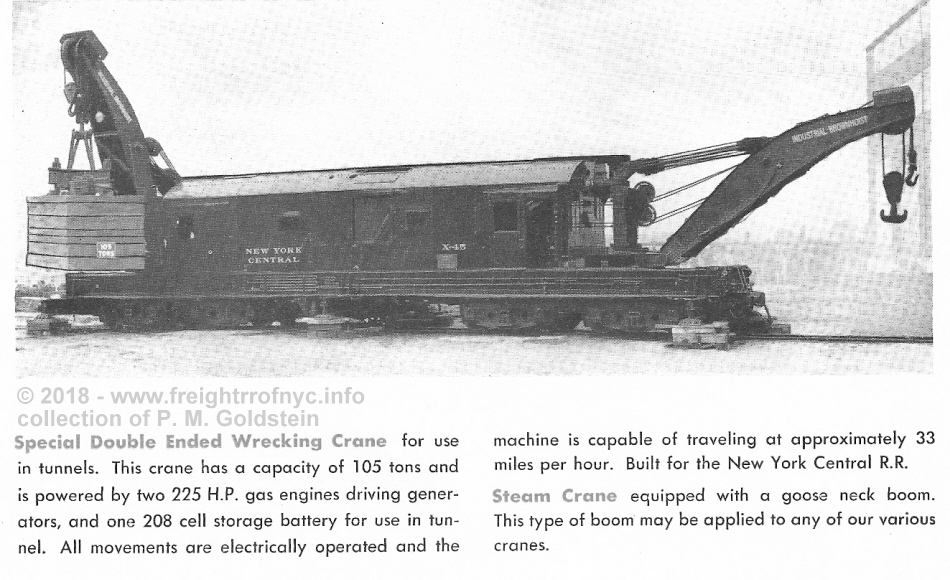
Industrial
Brownhoist General
Catalog Number 944 (September
1944) - Page 35
collection of John C. La Rue,
Jr.
added 02 February 2012
.
.
John mentioned he was looking for a Penn Central Employees Time Table (ETT) that noted the speed restrictions for Grand Central Terminal #1. For a change, I had something to offer instead of request as I have in my collection two Penn Central ETT's (#3 and #4 - April 27, 1969 and October 26, 1969 respectively - see next chapter below). I acquired these ETT's for research on a completely different topic relating to the rail line that runs near my present home (Catskill Mountain Branch).
Later in our conversation, John had the idea of referencing New York Central ETT's as well, to see if X-45 and GCT #1 were listed in the same ETT. Most aggrevatingly, my father had in his collection an ETT from New York Central for the Grand Central Terminal ca. 1930's, but had me sell it on eBay back in 2006! Fortunately, as Paul Strubeck is so fond of saying, "the internet is our friend"; and upon my searching, I located a digital scan of NYC ETT #54A dated December 14, 1941 on the website canadasouthern.com.
Lo and behold, in the Electric and Steam Derrick chapter, the speed restrictions and special handling instructions for both Grand Central Terminal #1 and New York Central X-45 are listed individually! This confirms that both GCT #1 and NYC X-45 were assigned to the New York Area at the same time.
Furthermore, the restrictions for lifting on steel structures are different for GCT #1 and NYC X-45 (based on their different gross weights), thereby indicating two different wreckers. This prevents the erroneous conclusions of GCT #1 and NYC X-45 being the same wrecker, albeit in two different liveries.
Of equal importance, is that NYC X-45 is listed at this date, so we are now at least able to confirm its remaining presence in the United States at this date as well, and had not yet been sent to the Soviet Union during World War 2 (keeping in mind that it has not been irrefutably confirmed that NYC X-45 and Cleveland Union Terminal X-99 were sent to the Soviet Union to begin with).
Wait a minute... What's going on here? NYC X-45 is supposed to be a later livery of GCT #1. Well, thanks to these illustrations and ETT information, this is now confirmed to be not true.
It then appeared that X-45 was a later incarnation of X-99. This is now understood to be incorrect as well. By referencing the evidence at hand, New York Central #X-45 had an identical twin: Cleveland Union Terminal X-99, which we discuss in the next chapter.
Another interesting discovery, is the fact that Electro Motive Corporation (the predecessor to GM Electro Motive Division "EMD") built the propulsion systems and Industrial Brownhoist built the body, derrick and winch systems. While we have no information regarding this wrecker or its sister X-99 in the Industrial Brownhoist compilation, we do have some details from EMC.
The following excerpt is from "Interurban Without Wires" by Edmund Kielty:

"Interurban
Without Wires" by Edmund
Kielty, p. 118
authors
collection
added 05 February 2012
..
And so during my yearly visit to the Clark, NJ Train & Railroadiana Show in March 2012, I pay my customary visit to Bob's photos. Sure enough, Bob has but one image of a double ended wrecker, and that was NYC X45:

New
York Central X-45 - October 8,
1931 - Croton-Harmon
Yard, NY
unknown photographer
Bob's photo archives
authors collection
added 06 March 2012
.
.
Industrial
Brownhoist: c/n unknown
Electro Motive Corporation: c/n 447 - built 8/1930
Cleveland Union Terminal "CUT" X-99
.
While viewing photos on NE Rails researching the above information, I learned of this Cleveland Union Terminal double ended wrecker, a while back and prior to learning about the existence of New York Central X-45.
It also needs to be noted that from all historical accounts to date, Cleveland Union Terminal X-99 did not operate in the New York Area. This being the case, I at first did not intend to research it and publish images and my findings here; but as you can see, here I am explaining its history away!
It appears X-99 was built for similar purposes and therefore shares some similarities to Pennsylvania #490797 and Grand Central Terminal #1, but fortunately X-99 (and likewise X-45) are significantly different from Pennsylvania #490797 [to become Amtrak #16000] and Grand Central Terminal #1 [to become Penn Central #50021 / Metro-North #001], so as not to cause further confusion.
However when comparing Cleveland Union Terminal X-99 and New York Central X-45, they do appear to be identical to one another.
In the following two images, I took notice that the backgrounds are different. The first (unmarked wrecker) contains a cab from a wrecker in the left background and a cab on the right edge, so I believe this image to be a builders photo. The second photo appears to have been taken in a yard with freight cars and many tracks in the background, so I believe this to have been taken while in service somewhere in the Cleveland area..
John Taubeneck also took notice of something in the images in both the catalog and below:
"Note that the boom in the catalog cut of NYC #X45 is lettered Industrial Brownhoist. Industrial Works and Brown Hoisting Machinery merged to form IB on September 26, 1927. The photograph(s) would have had to be taken after that."

Industrial Brownhoist builders photo? -
circa August 1930
courtesy of North East
Rails
added 02 February 2012
.
.

Cleveland
Union
Terminal - ca. August 1930
courtesy of North East Rails
added 02 February 2012
.
.

Industrial
Brownhoist General
Catalog Number 944 (September
1944) - Page 35
collection of John C. La Rue,
Jr.
added 02 February 2012
.
.
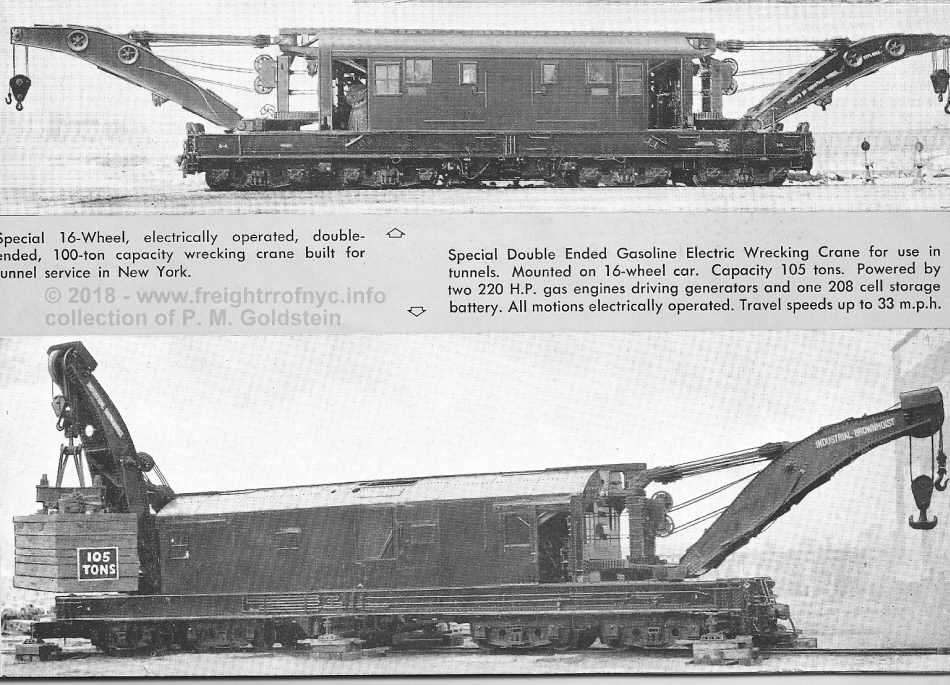
Industrial
Brownhoist General
Catalog Number 647 (June
1947) - Page 25
collection of John C. La Rue,
Jr.
added 02 February 2012
.
.
Recognizable differences between PRR 490797 and GCT 1 with CUT X-99 and NYC X-45 are as follows:
There
are small holes in the roof towards the middle of the body of CUT X-99
and NYC X-45 that are not present on PRR 490797 or GCT 1.
I attribute these to being exhaust ports for the internal combustion
engine which was used to power the generator to provide electricity for
the crane motors and winches. Therefore, CUT X-99 and NYC X-45 could
produce their own power supply.
The sides of the booms on X-99 and X-45 lack auxiliary winch sheaves, of which both PRR 490797 and GCT 1 both have.
There are covers protecting the sheaves and boom tips on CUT X-99 and NYC X-45, from contact with overhead catenary. Neither PRR #490797 or GCT #1 have these covers.
.
Now for those of you are paying attention, note the bottom wrecker illustrated in both Catalog 944 and 647: it is the same image, only in the Catalog 647 image: "NEW YORK CENTRAL" and "X-45" has been airbrushed out and a larger sign "105 tons" pasted on the load! This type of image modification was common in company brochures, and it exactly this that can cause problems and confusion in research.
In addition, John LaRue and I noticed something else: the wrecker marked as X-45 in Catalog 944 looks identical to CUT X-99. Holes in roof for exhaust, catenary protector for boom tip, and door / window placement all conforms to CUT X-99.
As with New York Central X-45, is must be kept in mind that Electro Motive Corporation (the predecessor to GM Electro Motive Division "EMD") built the propulsion systems and Industrial Brownhoist built the body, derrick and winch systems. While we have no information regarding this wrecker or its sister X-99 in the Industrial Brownhoist compilation, we do have some details from EMC obtained from "Interurban Without Wires" by Edmund Kielty, and this information can be viewed in the New York Central X-45 chapter above.
.
.
.
The following are scans of the respective Employee Time Tables referencing the individual wreckers and their operating restrictions:
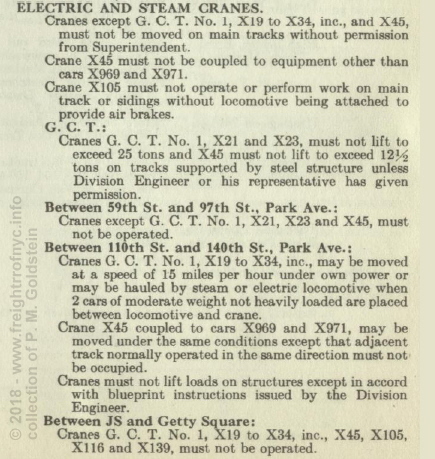
New York Central Employee Time Table 54A, page10 - December 14, 1941
courtesy of
www.canadasouthern.com
added 05 February 2012
.
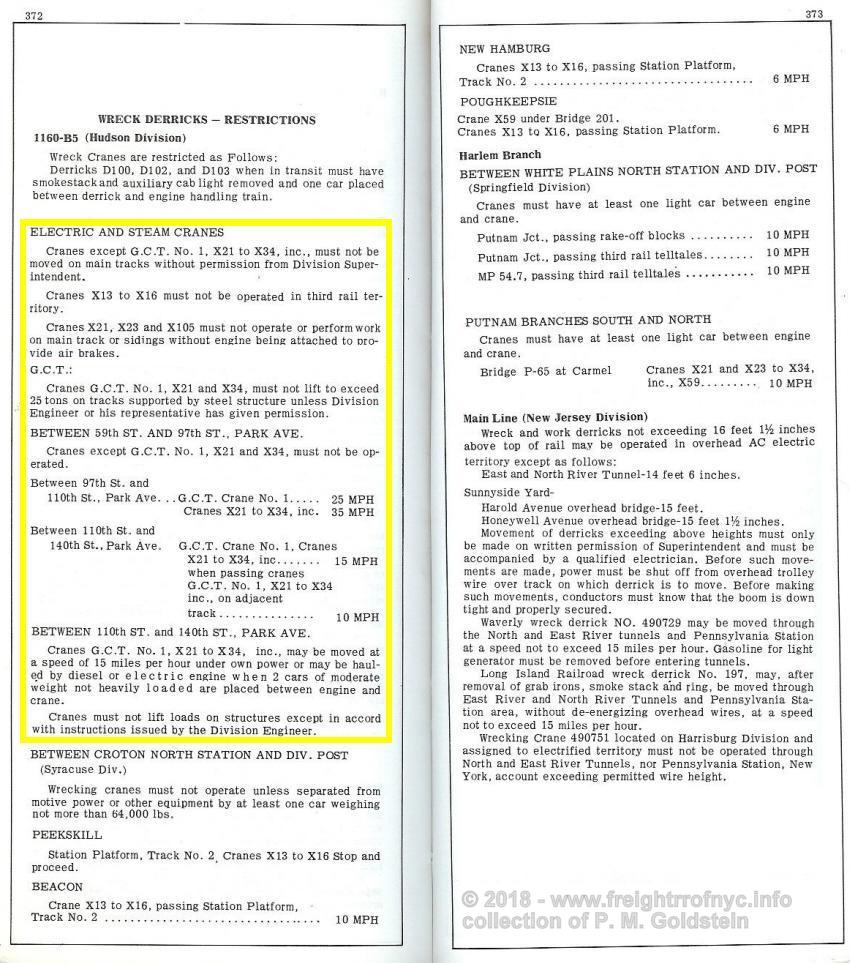
Penn
Central Employee's Timetable #3
New York Region - Hudson Division / New Jersey Division
in effect 4:01 am Sunday, April 27, 1969
P. M. Goldstein
collection
added 02 February 2012
.
.
Quick Reference Table of Design Differences
.
So, if you have not been able to follow all these design observations, here is a table of design differences between the three double ended wrecker units:
.
|
Industrial
Works - c/n 2280 Amtrak #16000 |
Industrial
Works - c/n 2281 |
|
|
| . | |
|
|
|
| . | |
|
body,
derrick &
winch by Industrial Brownhoist - c/n ? |
body,
derrick &
winch by Industrial Brownhoist - c/n ? |
| It appears that X-99 and X45 were built from the same plans and specifications appear to be identical to each other. | |
|
|
.
.
Recapitulation of the Dispositions of the Double Ended Wreckers
.
|
Industrial
Works c/n 2280 |
The final disposition for this wrecker is not confirmed, however it was seen in Sunnyside Yard, Queens in April 1983 by myself.
Two rumors are circulating about the disposition of this wrecker:
.
| 1) | "It fell off a carfloat in New York Harbor and sunk, and remains at the bottom of New York Harbor." |
|
This is highly unlikely as the
only rail-marine carfloating firm in existence after 1983 was New York
Cross Harbor Railroad. To date, none of the former NYCH employees I am
in contact with, recall a carfloat move of any wrecker, much
less one of this size and losing it overboard.
Furthermore, something of this size would probably not be left on the bottom of the Harbor to pose as an underwater obstruction for vessel traffic. Even smaller boxcars that have in fact fell off carfloats, were subsequently raised. . |
|
| 2) | The other rumor is that, "this wrecker tipped over in Sunnyside, and was scrapped on the spot." |
| This scenario is significantly more believable, taking into account of difficulty of righting the wrecker with an overhead catenary and third rail as Sunnyside is so equipped. |
Whatever the reason, it is shown redacted from Amtrak's roster by September 1983.
.
|
Industrial
Works c/n 2281 |
The only confirmed disposition for any of the
double ended wreckers,
is for Industrial Works c/n 2281 "Grand Central Terminal #1"
(a/k/a
"Penn Central #50021" / "Conrail #50021" / Metro-North #001).
This wrecker is the only known surviving double
ended wrecker
and is currently on display at the Danbury Railway Museum, in Danbury,
CT.
It has been restored to its original GCT #1 appearance.
However, it should be noted that Metro-North has only leased the wrecker for display at the Danbury Railway Museum, and retains the option on requesting its return and reactivating the wrecker at their discretion. As the Danbury Railway Museum is not "landlocked" and remains connected to active Metro-North trackage, it would not be difficult to return the wrecker to "live" trackage.
.
|
Industrial
Works c/n ? |
.
|
Industrial
Works c/n ? |
Both NYC X-45 and CUT X-99 appear to have been sent to Soviet Railways (perhaps as part of the lend / lease program?) and both were in the process of being sent to the Soviet Union during World War II, but were allegedly sunk during transit.
..
Anyone with information or dated photos proving or disproving these dispositions, is more than welcome to contact me at bedt14@aol.com .
.
Industrial Works / Industrial Brownhoist Double Ended Wrecker Roster
|
Industrial Works
present location: |
... |
Industrial Works
present
location: |
|||||||||||||||||||||||||||||||||
| 1
Industrial
Works catalog lists this wrecker as having a 65 ton capacity. It is believed this 65 ton capacity including the "whip line" (auxiliary hoist at mid boom) 2
John Taubeneck's compilation has c/n
2280 listed 3
J. Lubchansky (via S.
Berliner) advises that a wrecker |
4
PC ETT #3 & #4 (April
& October 1969 respectively) still refer to c/n 2281 as GCT 1 not 50021. |
||||||||||||||||||||||||||||||||||
| .
. |
|||||||||||||||||||||||||||||||||||
|
Industrial
Brownhoist &
present
location: sent to
Soviet Railways, ca. WW2
|
Industrial
Brownhoist &
present
location: sent to
Soviet Railways, ca. WW2 |
||||||||||||||||||||||||||||||||||
| 5 From
Yahoo.com Group
"Doodlebugs", message 227: NYC X45 - Serial #446; o/n: 10096, built 8/1930 - Self propelled Industrial Brownhoist double-ended wreck crane for use in New York City electrified zone. Sold to Soviet Railways (no date). CUT
X99 - Serial #447; o/n: 10096, built 9/1930 - Self propelled 6
Via
S. Berliner personal notes from B. Edson of NYC Equipment or P. Brustman :
"one (or both) was (were) shipped to
Russia |
|||||||||||||||||||||||||||||||||||
.
.
.
|
||||
|
|
||||
| .
. |
||||
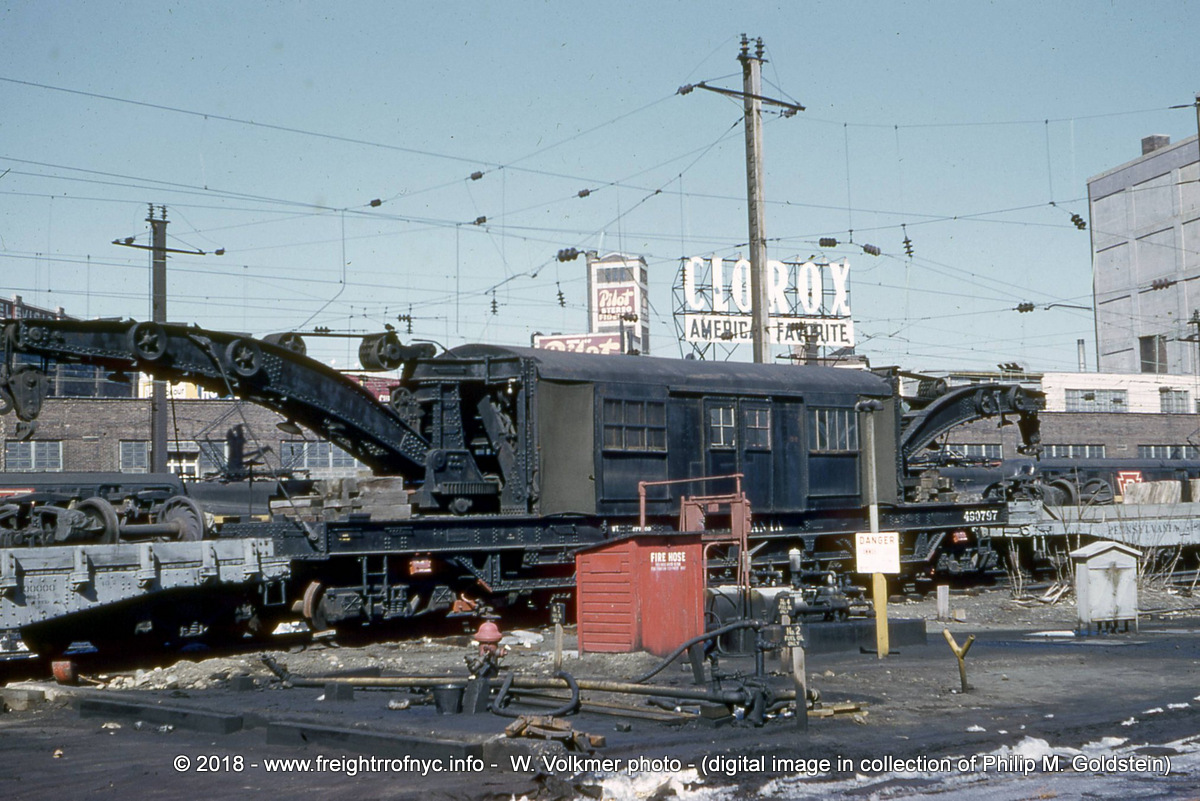 Pennsylvania Railroad
#490797 - March 1960
- Sunnyside Yard, Queens, NY
[to become Amtrak
#16000]
W. Volkmer photo source unknown (if anyone knowns please contact me) P. M. Goldstein collection added 02 July 2018 |
||||
| .
. |
||||
|
|
||||
| .
. |
||||
|
|
||||
| .
. |
||||
|
|
||||
| .
. |
||||
|
|
||||
| .
. |
||||
|
|
||||
| .
. |
||||
|
|
||||
| .
. |
||||
|
|
||||
| .
. |
||||
|
|
||||
| .
. |
||||
|
|
||||
| .
. |
||||
|
|
||||
| .
. |
||||
|
|
.
.
|
||||
|
|
||||
| .
. |
||||
|
|
||||
|
|
||||
| .
. |
||||
|
|
.
|
||||
|
|
.
|
||||
|
|
I welcome all information and photos. Please feel free to contact me at:
.
.
You would not think there would be any memorabilia for something as obscure as these double ended wreckers. But imagine my surprise, when Paul Strubeck located the following item on eBay. It was listed as a "cigarette card, special locomotive crane, american railroad company" with the description giving the date as 1936. It was not listed for which brand of German cigerettes. Also, because the monetary unit is listed as RM, this denotes ReichMarks. Therefore this card had to have been produced between 1928 and 1948. (As the wrecker wasn't built until 1930, we can conclude the card was made after this date).
I have also used an online translator to attempt to translate the text to English and of which appears below the reverse of the card. If any viewers out there who speak fluent German see an error, feel free to contact me with corrections.
Never the less, it now resides proudly in my collection!
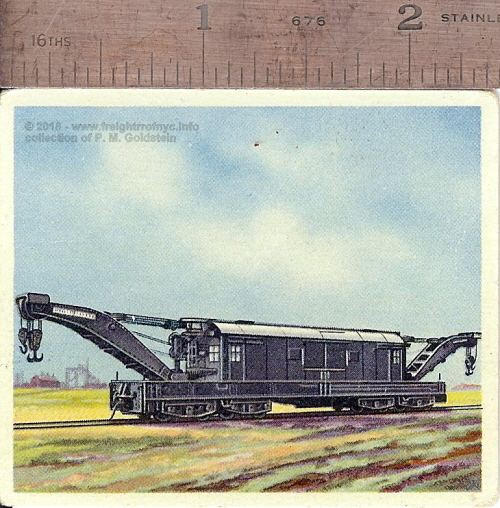 |
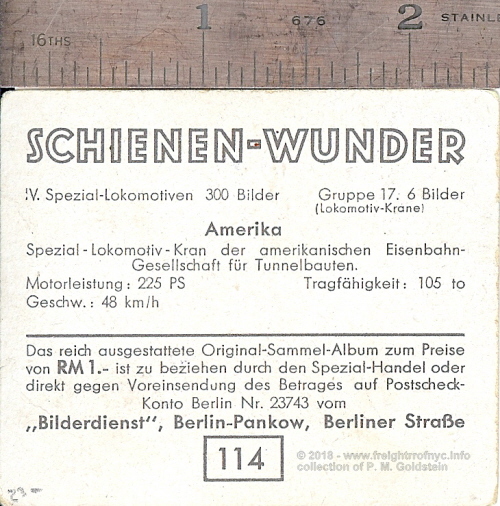 |
||||||||||||||||||
|
|||||||||||||||||||
.
Sam
Berliner
Lon Godshall
John LaRue
Ted Bowen, Manager; Metro-North Customer Service Center
Benjamin W. Schaffer
Paul F. Strubeck
John Taubeneck
Joseph Testagrose
Patty Osmer & Danbury Railway Museum
North East Railfan.net Photo Archives
.
Like what you see? Suggestions? Comments?